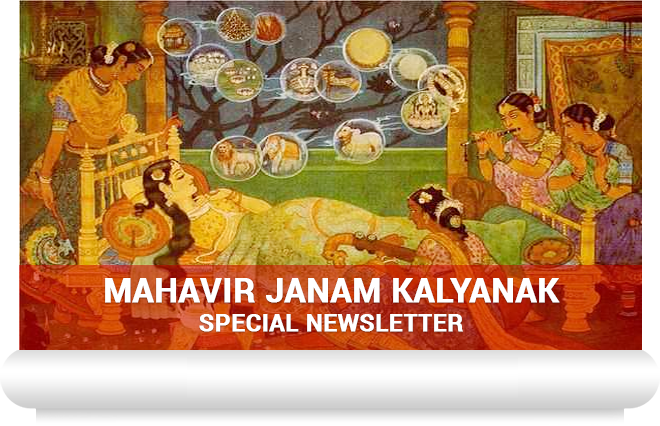| | | 1. PRESIDENT'S MESSAGE  Jai Jinendra! Jai Jinendra!
Greetings to you and family on this auspicious occasion of Mahavir Janma Kalyanak. Through-out the world, Mahavir Janma Kalyanak celebrations are being held.
We all are blessed to inherit such a great religion. Bhagwan Mahavir has given the world a unique message of Non-Violence. Today, His teachings are very relevant to resolve many disputes across the globe.
Sincerely,
Ashok Domadia
JAINA President & Chairman
| | 2. BHAGWAN MAHAVIR FULL LIFE STORY
|  | | 3. MATA TRISHLA’S 14 AUSPICIOUS DREAMS 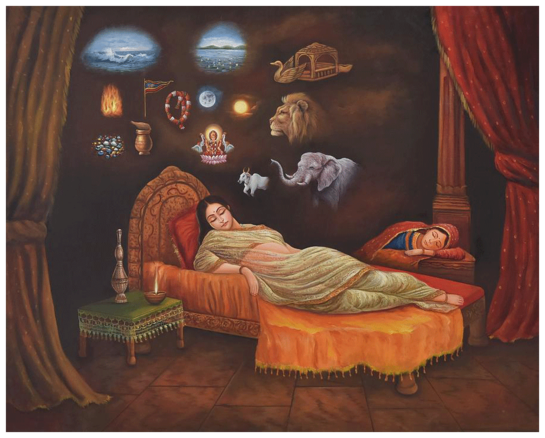 Queen Trishala saw 14 auspicious dreams when Lord Mahavir’s soul was conceived in her womb. The dreams filled her with wonder and joy. Next day,King Siddharth summoned the scholars to his court and asked them about the meaning of these 14 dreams; Queen Trishala saw 14 auspicious dreams when Lord Mahavir’s soul was conceived in her womb. The dreams filled her with wonder and joy. Next day,King Siddharth summoned the scholars to his court and asked them about the meaning of these 14 dreams;
1) Elephant - The dream of an Elephant with four tusks indicates that her son would guide the spiritual chariot with its four components-Sadhu,Sadhavi,Shravak and Shravikas.
2) Bull - The dream of bright colored white bull indicates that her son will be a spiritual leader of great ascetics, kings and other great personalities.
3) Lion - The dream of lion indicates that her son will be as powerful and as strong as lion. He will be fearless, mighty and capable of ruling over the world.
4) Goddess Laxmi - The dream of Goddess Laxmi indicates that her son will attain great wealth, power and prosperity.
5) Garland of Flowers - indicates that the fragrance of her son’s preaching will spread over the entire universe.
6) Full moon - indicates that the child will have a great physical structure and be pleasing to all living beings of the universe.
7) Sun - indicates that the teaching of his son will destroy anger, pride, deceit, greed from the life of the people.
8) Large flag - indicates that her son will be great, noble and a well respected leader of the family.
9) Silver Urn - indicates that her son will be perfect in all virtues.
10) Lotus - Lake- indicates that he will help to liberate the human being who are tangled in the cycle of birth, death and misery.
11) Milky-Sea - indicates that he will navigate through life on an ocean of birth, death and misery leading to moksh.
12) Celestial air-plane - indicates that all the god and goddesses in heaven will respect and salute to his spiritual teachings and will obey him.
13) Heap of Gems - indicates that he will have infinite virtues and wisdom.
14) Smokeless fire - indicates that the wisdom of her son will excel the wisdom of all other great people.
| | 4. FACTS ABOUT BHAGWAN MAHAVIR 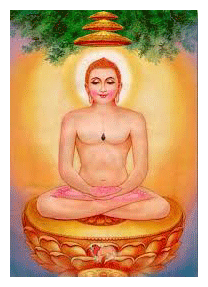 Mahavira,also known as Vardhaman,was twenty-fourth and last Jain Tirthankar. Mahavira was born to king Siddharth and queen Trishala on thirteenth day of rising moon of chaitra month. There are many variations in the birth place of Lord Mahavir;some says it was Kundigram,some says Lachhuar, some says Kundalpur,Nalanda. However exact birth place is unidentified. His childhood name was Vardhaman means ever increasing. When Vardhaman was in his mother’s womb, wealth, prosperity, peace, harmony started increasing tremendously so his name was kept Vardhaman. He later came to be known as Mahavir. Following his parents instructions, he married princess Yashoda and the couple had a daughter, Priyadarshana and son-in-law Jamali. Nandivardhan was his elder brother. Mahavira,also known as Vardhaman,was twenty-fourth and last Jain Tirthankar. Mahavira was born to king Siddharth and queen Trishala on thirteenth day of rising moon of chaitra month. There are many variations in the birth place of Lord Mahavir;some says it was Kundigram,some says Lachhuar, some says Kundalpur,Nalanda. However exact birth place is unidentified. His childhood name was Vardhaman means ever increasing. When Vardhaman was in his mother’s womb, wealth, prosperity, peace, harmony started increasing tremendously so his name was kept Vardhaman. He later came to be known as Mahavir. Following his parents instructions, he married princess Yashoda and the couple had a daughter, Priyadarshana and son-in-law Jamali. Nandivardhan was his elder brother.
|  | | 5. HOW VARDHMAN BECAME MAHAVIR 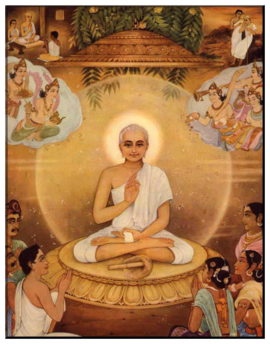 As a child, he was quiet but brave. He displayed acts of great courage several times during difficult situations. One day Vardhaman was playing in the garden of palace with his friends. Listening about his bravery and courage a deity named Sangam came there from the heaven to test his qualities in the form of a large ferocious cobra. All the children started running here and there, but Vardhaman was not disturbed at all, showing great courage, he started playing on the hood of the snake like the lap of mother. Then Sangam dev appeared in his real form and appreciated the strength and patience of Vardhaman again and again and named him a ‘MAHAVIR’. Being prince he was brought up amidst much luxury yet nothing affected him and he led a very simple life. As a child, he was quiet but brave. He displayed acts of great courage several times during difficult situations. One day Vardhaman was playing in the garden of palace with his friends. Listening about his bravery and courage a deity named Sangam came there from the heaven to test his qualities in the form of a large ferocious cobra. All the children started running here and there, but Vardhaman was not disturbed at all, showing great courage, he started playing on the hood of the snake like the lap of mother. Then Sangam dev appeared in his real form and appreciated the strength and patience of Vardhaman again and again and named him a ‘MAHAVIR’. Being prince he was brought up amidst much luxury yet nothing affected him and he led a very simple life.
| | 6.DREAMS OF BHAGWAN MAHAVIR 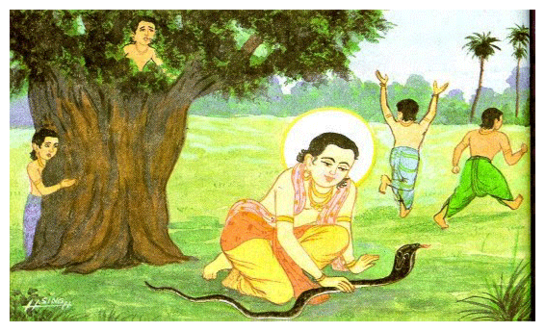 A Tirthankar is an enlightened soul who is born as a human being and attains perfections through intense meditation. At the age of 30, Vardhaman left his home in pursuit of spiritual awakening and for the next twelve-and-a-half years, he practiced severe meditation and penance to drive away his basic attachments. He practiced complete silence and rigorous meditation to conquer his basic desires. He practiced philosophy of non-violence against all living beings. He moved from place to place often observing fasts. During his twelve years of sadhana kal, he travelled through Bihar, western and north Bengal, parts of Orissa and Utter Pradesh. A Tirthankar is an enlightened soul who is born as a human being and attains perfections through intense meditation. At the age of 30, Vardhaman left his home in pursuit of spiritual awakening and for the next twelve-and-a-half years, he practiced severe meditation and penance to drive away his basic attachments. He practiced complete silence and rigorous meditation to conquer his basic desires. He practiced philosophy of non-violence against all living beings. He moved from place to place often observing fasts. During his twelve years of sadhana kal, he travelled through Bihar, western and north Bengal, parts of Orissa and Utter Pradesh.
After experiencing 12 years of hard penance, Mahavir is said to have fallen asleep for a few moments when he experienced a series of 10 strange dreams. These dreams and their significance have been explained in Jain scriptures as follows:
1) Defeating a Lion—signifies destruction of ‘Mohaniya karma’ or wordly attachments.
2) A bird with white feathers following his—signifies attainment of purity of mind.
3) A bird with multi colored feathers—signifies attainment and propagation of multifaceted knowledge.
4) Two gem strings appear in front—symbolizes preaching a dual religion, an amalgamation of principles from a monk’s life and duties of a common man.
5) A herd of white cows—symbolizes a group of devoted followers who will serve.
6) A pond with open lotus—symbolizes presence of celestial spirits who will propagate the cause.
7) Crossed a waxy ocean swimming—symbolizes freedom from the cycles of death and re-birth.
8) Sun rays spreading in all directions—symbolizes attainment of Kevalgyan.
9) Enriching the mountain with bluish intestines—symbolizes the universe will be privy to the knowledge.
10) Sitting on a throne placed on summit of the Mount Meru—symbolizes people revering the knowledge being taught and placing Mahavir in a place of respect.
|  | | 7. TEACHINGS OF BHAGWAN MAHAVIR 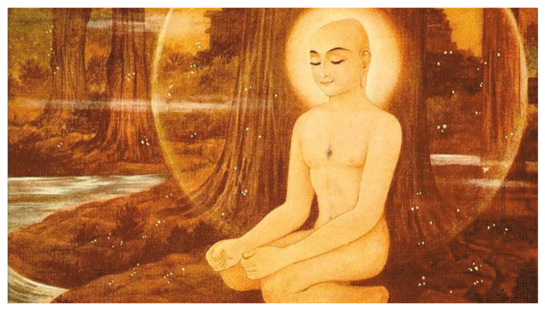 On the tenth day of the rising moon during the month of Vaisakh,557 B.C, Mahavir sat under a Sal tree on the banks of river Rijuvalika (modern day river Barakar),and attained the Kevalgyan or omniscience. He finally experienced perfect perception, perfect knowledge, perfect conduct, unlimited energy and unobstructed bliss. He became a Jina, the one who is victorious over attachments. On the tenth day of the rising moon during the month of Vaisakh,557 B.C, Mahavir sat under a Sal tree on the banks of river Rijuvalika (modern day river Barakar),and attained the Kevalgyan or omniscience. He finally experienced perfect perception, perfect knowledge, perfect conduct, unlimited energy and unobstructed bliss. He became a Jina, the one who is victorious over attachments.
After kevalgyan,Lord Mahavir’s first deshana (preaching) was not successful so second one was held at the city of Pava in the garden of Mahasena. Here his words of wisdom resonated with the masses and eleven Brahmins chose to embrace his preaching and convert to Jainism. Mahavir imparted the ‘Tripadi’ to his chief disciples which were UPENEIVA (Emergence), VIGAMEIVA (Distruction) and DHUVEIVA (Permanence).
The eleven chief disciples (Gandhars) brought their own followers into the fold of his teachings.4400 followers became first of the Jain shramans. Eventually common people also joined in order and Mahavir ultimately lead a community of 14000 monks,36000 sadhvijis, 159000 shravakas and 318000 shravikas. These four group constitutes the fourfold order of four tirthas of Jainism. Some of his royal followers included King Chetak of Vaishali, King Shrenik, Bimbisar and Ajatshatru of Rajgriha, King Udayana, King Chandrapradyot, Nine Licchavis, King of Koshal and Nine kings of Kashi.
Mahavir devoted life towards spreading his kevalgyan among people and gave discourses in local languages as opposed to in elite Sanskrit. His final discourse was at Pavapuri which lasted for 48 hours. He attained moksha shortly after his final discourse, finally liberated from the cycle of birth and death during 527 B.C. at the age of 72.
Sermons of Lord Mahavir were compiled in the Agam Sutras by his Gandhars and were passed on to common people through oral recitations. These scriptures prescribed 5 basic vows that should be observed by everyone which are as follows:
1) Non-violence(Ahimsa)—not to cause harm to any living beings. 2) Truthfulness(Satya)—to speak harmless truth only. 3) Non-stealing(asteya)—not to take anything not properly given. 4) Chastity(Brahmcharya)—not to indulge in sensual pleasure. 5) Non-possession(Aparigraha)—complete detachment from people,places and material things.
Mahavir choose an extremely ascetic life. While enduring the penance, he controlled his senses. His courage and exemplary action in controlling the senses earned him the name Mahavir. ‘LIVE AND LET LIVE’ one of the most important and famous slogan was introduced in this world by none other than Lord Mahavir. This slogan gives us the basis of leading a life peacefully.
| | 8. MAHAVIR JANMA KALYANAK- CELEBRATIONS 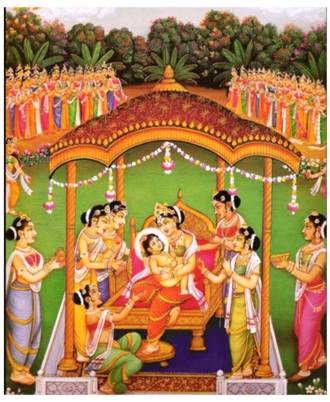 The most important places of celebrations of Mahavir Jayanti are Gujarat and Rajasthan. Gujarat is said to have maximum number of Jain shrines. In India, Gujarat holds the biggest fair for this festival. Palitana and Girnar are some of the most significant places of worship of the state. On this auspicious day, all the holy places and temples associated with Mahavir are decorated with flowers, flags and diyas. The Mahavir idol is given a ritual bath before celebration and puja following a big and a grand procession. On this day, chariot processions with the images of Mahavir are taken out. The most important places of celebrations of Mahavir Jayanti are Gujarat and Rajasthan. Gujarat is said to have maximum number of Jain shrines. In India, Gujarat holds the biggest fair for this festival. Palitana and Girnar are some of the most significant places of worship of the state. On this auspicious day, all the holy places and temples associated with Mahavir are decorated with flowers, flags and diyas. The Mahavir idol is given a ritual bath before celebration and puja following a big and a grand procession. On this day, chariot processions with the images of Mahavir are taken out.
There is a tradition of distributing clothes, money, food and other necessary things to the needy people. Such facilities are organized by the Jain organizations. People get involved in charitable act, also they perform meditation and offer prayers. Lectures are organised in the temple to distribute the virtue of Jain doctrine, importance of Ahimsa, Anekant and Aprigraha. Devotees and followers of Jainism send Mahavir Jayanti messages to re-live the great teachings and life of Mahavir.
|  | | 9. VATICAN'S MESSAGE TO JAINS ON THE OCCASION OF MAHAVIR JAYANTI 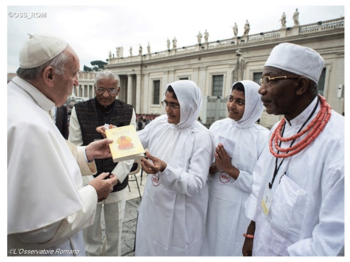 Dear Jain Friends, Dear Jain Friends,
The Pontifical Council for Interreligious Dialogue sends you its warmest felicitations as you celebrate the 2615th Birth Anniversary of Tirthankar Vardhaman Mahavir on 9th April, this year. May this festive event bring happiness and peace in your hearts, families and communities!
Violence, with its many and varied forms, has become a major concern in most parts of the world. So, we wish to share with you on this occasion a reflection on how we, both Christians and Jains, can foster non-violence in families to nurture peace in society.
| | 10. MAHAVIR JANMA KALYANAK CELEBRATION 2017 Jain Centers of USA and Canada are getting ready to celebrate Mahavir Janma Kalyanak. This list will help you know program details for Jain Centers near to you.
|  | 11. CHILDREN'S CORNER 
To get the answer please visit website | | DOWN:
1) Mahavira was the last ________ which means teachers who make a ford
2) The name of Mahavira's mother
4) Mahavira achieved liberation or _______ in 527 BC
5) The modern state of India where Mahavira was born
6) His family followed the teachings of ________
ACROSS:
3) The number of dreams that his mother has in one night before Mahavira was born
7) The name of Mahavir's father | | | | | |

